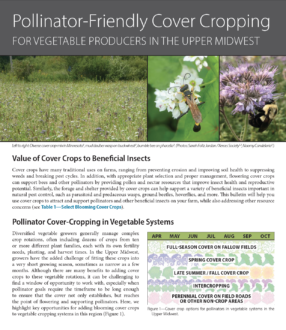Growers are increasingly interested in adding cover crops to rotations to improve soil health, break disease cycles, and provide ecosystem services. In addition to these benefits, cover crops present an opportunity to add crucial floral resources and habitat for pollinators and other beneficial insects on the farm. However, identifying appropriate cover crop species and management practices can be challenging. Growers must balance cash crop goals and timing with limited labor, land, and equipment availability.
University of Minnesota experts and the Xerces Society collaborated with Midwest farmers on this bulletin. It aims to assist farmers and managers in utilizing cover crops to attract and support pollinators and beneficial insects on Upper Midwest vegetable farms while addressing additional resource concerns. It also includes new research findings on flowering summer cover crops, an often overlooked and minimally researched option for growers in the Upper Midwest.
Want more information? See the related SARE grant:
This material is based upon work that is supported by the National Institute of Food and Agriculture, U.S. Department of Agriculture through the Sustainable Agriculture Research and Education (SARE) program. Any opinions, findings, conclusions, or recommendations expressed in this publication are those of the author(s) and should not be construed to represent any official USDA or U.S. Government determination or policy.
